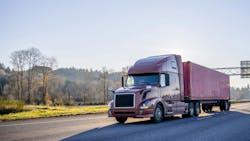Want long-term profitability for your fleet? It starts with a safety culture
Compound interest. Not the most engaging topic, but there’s a rumor that Einstein once referred to it as the most powerful force in the universe.
Whether he actually said anything about it, the idea has weight. Because once you set an investment in motion, over time it can snowball into something significant. The same can be said about your investment in safety programs and its impact on driving profitability for your fleet.
We recently caught up with Chris Henry, COO of transportation consulting firm KSM Transport Advisors. We discussed the idea of a compounding force of safety and why turning your safety goals into regular habits will, over time, unlock some surprising financial benefits: roughly 10 cents per mile per truck.
Building a safety-first culture
Every company that excels in safety has created programs and shifted attitudes that are now baked into their corporate culture. Without the cultural buy-in, safety programs can wither. But the hidden advantage of a solid safety program is that it’s a place to maximize profits. The top fleets know this, and they actively work to manage these programs to see those returns.
The trick, though, is that the return on safety (or safety as a profit center) is a "slow burn," and you don’t see the payoff right away. But if a carrier can adopt the right habits and let them progress over time, you start to see the compounding effect.
Chatting with Chris, he told me it’s like going to the gym and working out. While you don’t see the benefit on the first day or even the first week, you begin to see the results over time.
Insurance cost per mile
When you’ve made the investment to bolster your safety programs, Chris says that the real monetary payoff comes in a carrier’s insurance cost per mile per truck. What kind of numbers are we talking about? It’s quite substantial.
To show how much costs can vary, let’s compare a company with a poor safety record against a company with an outstanding one. The underperforming company might be shouldering more than 25 cents in their insurance CPM, while the company with a superb safety record might be looking at a cost as small as 2 cents per mile.
But what about the average fleet? What’s the CPM range it should expect to pay? Chris says the companies he works with, which are in the top 50% of performers for safety, only see about a $0.045 CPM insurance cost. Companies that don’t prioritize safety pay closer to $0.14 CPM.
There’s the 10-cent difference—and it can significantly impact your bottom line.
See also: Heller: Don’t let safety go up in smoke
How to improve insurance CPM
You must take several factors into account when calculating your insurance CPM, some of which you can change and some you probably can't.
Unlikely to change? The type of freight you haul, fleet size, operating region, and annual mileage.
What you can change? Let’s take a look at three factors you can start to focus on right now:
- Driver training and safety record. Your drivers are the ones on the road, so they are going to be front and center in getting your safety numbers in line. When you engage people with a more robust training program (more content more often, better tracking on completion and re-certification, etc.), you’ll start to see better, safer runs from them over time.
- Enhanced safety measures. Telematics can give you a more granular look at what’s happening on the road—where things are going right and where they’re not. Simply putting dashcams in trucks won’t get you there; taking safety seriously requires lots of follow-up programs to generate lower incident rates. Whatever you are learning from that new data, you’ve got to be ready with the right interventions and follow-up programs.
- Claims history and more. By investing in those other safety factors, you’ll start to see a reduction in accidents and incidents, and ultimately, the number of claims you need to make will decrease. Safety audits will run more smoothly. Your risk profile with your insurer will improve.
To effectively improve your insurance CPM, focus on these and the other factors that enhance safety. The key is to start small and avoid trying to do everything at once. Start with the low-hanging fruit, with small, achievable goals. As you develop your safety program, communicate your goals and get feedback from drivers and the office staff who support them.
The additive, compounding force of all these elements grinding away over the long term uses the same idea as compound interest: Set the process in motion, keep an eye on it, and let the benefits build. You will begin to see progressively better value in your insurance CPM.
About the Author

Jane Jazrawy
CEO
Jane Jazrawy is the CEO of CarriersEdge, providers of online safety and compliance training tools for the North American transportation industry, and co-creator of the Best Fleets to Drive For. Jane has been a leader in education and performance improvement for more than 25 years, and through Best Fleets, works to promote positive and diverse workplaces in the trucking industry.
